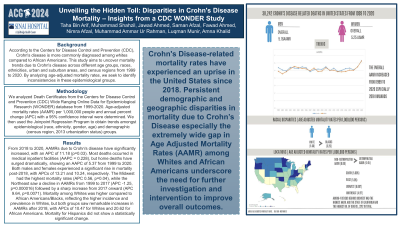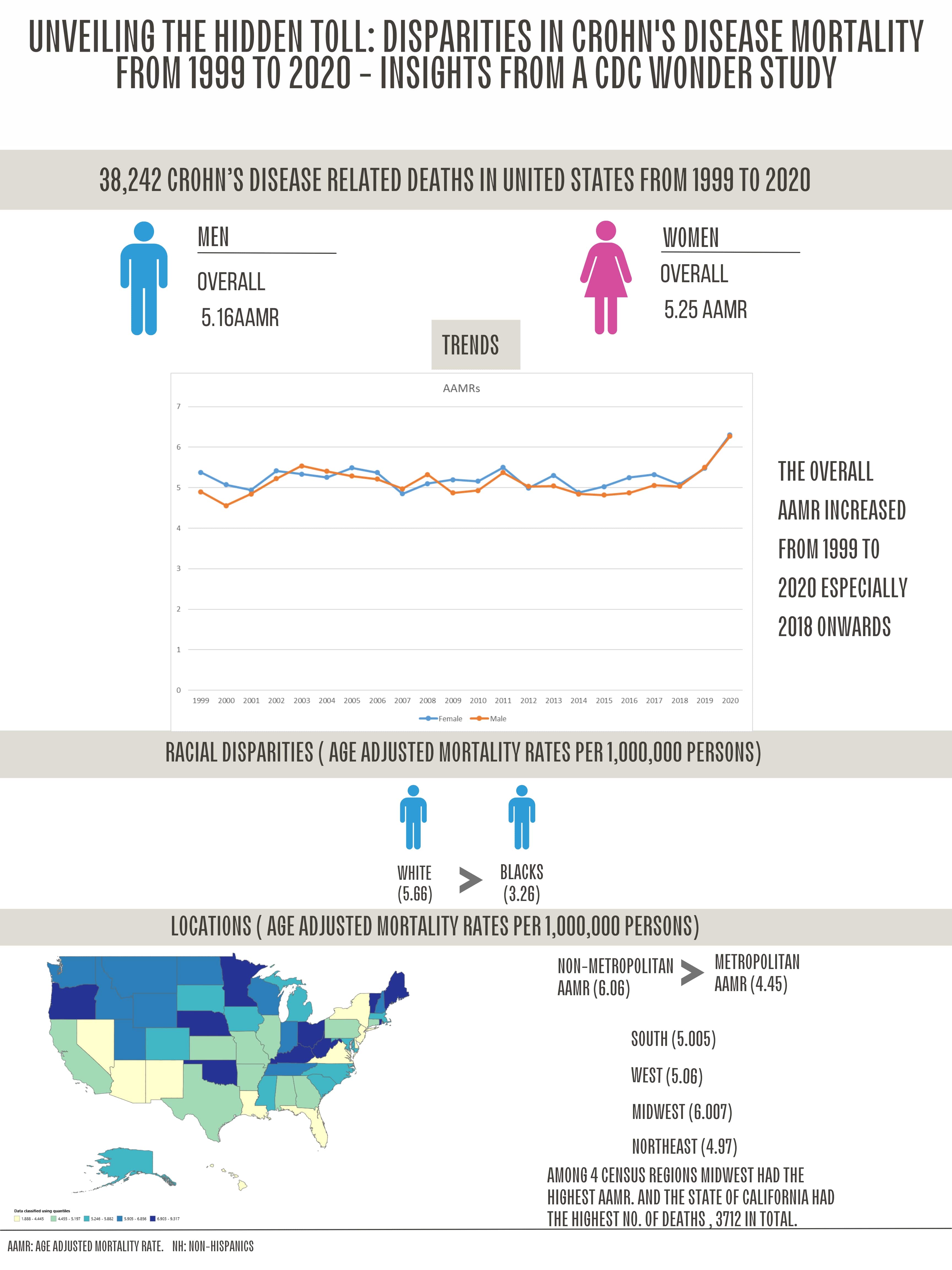Monday Poster Session
Category: Small Intestine
P3182 - Unveiling the Hidden Toll: Disparities in Crohn's Disease Mortality – Insights from a CDC WONDER Study
Monday, October 28, 2024
10:30 AM - 4:00 PM ET
Location: Exhibit Hall E

Has Audio

Taha Bin Arif, MBBS, MD
Sinai Hospital
Baltimore, MD
Presenting Author(s)
Taha Bin Arif, MBBS, MD1, Muhammad Shahzil, MD2, Jawad Ahmed, MBBS3, Saman Afzal, MBBS3, Fawad Ahmed, MBBS3, Nimra Afzal, MBBS3, Muhammad Ammar Ur Rahman, MBBS3, Luqman Munir, MBBS3, Amna Khalid, MBBS3
1Sinai Hospital, Baltimore, MD; 2Penn State Health Milton S. Hershey Medical Center, Hershey, PA; 3King Edward Medical University, Lahore, Punjab, Pakistan
Introduction: According to the Centers for Disease Control and Prevention (CDC), Crohn's disease is more commonly diagnosed among whites compared to African Americans. This study aims to uncover mortality trends due to Crohn's disease across different age groups, races, ethnicities, urban and suburban areas, and census regions from 1999 to 2020. By analyzing age-adjusted mortality rates, we seek to identify inconsistencies in these epidemiological groups.
Methods: We analyzed Death Certificates from the Centers for Disease Control and Prevention (CDC) Wide Ranging Online Data for Epidemiological Research (WONDER) database from 1999-2020. Age-adjusted mortality rates (AAMR) per 1,000,000 people and annual percent change (APC) with a 95% confidence interval were determined. We then used the Joinpoint Regression Program to obtain trends amongst epidemiological (race, ethnicity, gender, age) and demographic (census region, 2013 urbanization status) groups.
Results: From 2018 to 2020, AAMRs due to Crohn's disease have significantly increased, with an APC of 11.18 (p=0.03). Most deaths occurred in medical inpatient facilities (AAPC = 0.228), but home deaths have surged dramatically, showing an AAPC of 5.37 from 1999 to 2020. Both males and females experienced a significant rise in mortality post-2018, with APCs of 13.21 and 10.24, respectively. The Midwest had the highest mortality rates (APC 0.56, p=0.04), while the Northeast saw a decline in AAMRs from 1999 to 2017 (APC -1.25, p=0.000016) followed by a sharp increase from 2017 onward (APC 9.64, p=0.0071). Mortality among Whites was higher compared to African Americans/Blacks, reflecting the higher incidence and prevalence in Whites, but both groups saw remarkable increases in AAMRs after 2018, with APCs of 10.47 for Whites and 20.62 for African Americans. Mortality for Hispanics did not show a statistically significant change.
Discussion: Crohn's disease is a chronic inflammatory bowel disease that can affect any part of the gastrointestinal tract, but it most commonly affects the end of the small intestine (ileum) and the beginning of the colon. Crohn's Disease-related mortality rates have experienced an uprise in the United States since 2018. Persistent demographic and geographic disparities in mortality due to Crohn's disease especially the extremely wide gap in AAMR among Whites and African Americans underscore the need for further investigation and intervention to improve overall outcomes.

Disclosures:
Taha Bin Arif, MBBS, MD1, Muhammad Shahzil, MD2, Jawad Ahmed, MBBS3, Saman Afzal, MBBS3, Fawad Ahmed, MBBS3, Nimra Afzal, MBBS3, Muhammad Ammar Ur Rahman, MBBS3, Luqman Munir, MBBS3, Amna Khalid, MBBS3. P3182 - Unveiling the Hidden Toll: Disparities in Crohn's Disease Mortality – Insights from a CDC WONDER Study, ACG 2024 Annual Scientific Meeting Abstracts. Philadelphia, PA: American College of Gastroenterology.
1Sinai Hospital, Baltimore, MD; 2Penn State Health Milton S. Hershey Medical Center, Hershey, PA; 3King Edward Medical University, Lahore, Punjab, Pakistan
Introduction: According to the Centers for Disease Control and Prevention (CDC), Crohn's disease is more commonly diagnosed among whites compared to African Americans. This study aims to uncover mortality trends due to Crohn's disease across different age groups, races, ethnicities, urban and suburban areas, and census regions from 1999 to 2020. By analyzing age-adjusted mortality rates, we seek to identify inconsistencies in these epidemiological groups.
Methods: We analyzed Death Certificates from the Centers for Disease Control and Prevention (CDC) Wide Ranging Online Data for Epidemiological Research (WONDER) database from 1999-2020. Age-adjusted mortality rates (AAMR) per 1,000,000 people and annual percent change (APC) with a 95% confidence interval were determined. We then used the Joinpoint Regression Program to obtain trends amongst epidemiological (race, ethnicity, gender, age) and demographic (census region, 2013 urbanization status) groups.
Results: From 2018 to 2020, AAMRs due to Crohn's disease have significantly increased, with an APC of 11.18 (p=0.03). Most deaths occurred in medical inpatient facilities (AAPC = 0.228), but home deaths have surged dramatically, showing an AAPC of 5.37 from 1999 to 2020. Both males and females experienced a significant rise in mortality post-2018, with APCs of 13.21 and 10.24, respectively. The Midwest had the highest mortality rates (APC 0.56, p=0.04), while the Northeast saw a decline in AAMRs from 1999 to 2017 (APC -1.25, p=0.000016) followed by a sharp increase from 2017 onward (APC 9.64, p=0.0071). Mortality among Whites was higher compared to African Americans/Blacks, reflecting the higher incidence and prevalence in Whites, but both groups saw remarkable increases in AAMRs after 2018, with APCs of 10.47 for Whites and 20.62 for African Americans. Mortality for Hispanics did not show a statistically significant change.
Discussion: Crohn's disease is a chronic inflammatory bowel disease that can affect any part of the gastrointestinal tract, but it most commonly affects the end of the small intestine (ileum) and the beginning of the colon. Crohn's Disease-related mortality rates have experienced an uprise in the United States since 2018. Persistent demographic and geographic disparities in mortality due to Crohn's disease especially the extremely wide gap in AAMR among Whites and African Americans underscore the need for further investigation and intervention to improve overall outcomes.

Figure: Figure 1: Graphical illustration of findings from the disparities in Crohn's Disease mortality from 1999 to 2020.
Disclosures:
Taha Bin Arif indicated no relevant financial relationships.
Muhammad Shahzil indicated no relevant financial relationships.
Jawad Ahmed indicated no relevant financial relationships.
Saman Afzal indicated no relevant financial relationships.
Fawad Ahmed indicated no relevant financial relationships.
Nimra Afzal indicated no relevant financial relationships.
Muhammad Ammar Ur Rahman indicated no relevant financial relationships.
Luqman Munir indicated no relevant financial relationships.
Amna Khalid indicated no relevant financial relationships.
Taha Bin Arif, MBBS, MD1, Muhammad Shahzil, MD2, Jawad Ahmed, MBBS3, Saman Afzal, MBBS3, Fawad Ahmed, MBBS3, Nimra Afzal, MBBS3, Muhammad Ammar Ur Rahman, MBBS3, Luqman Munir, MBBS3, Amna Khalid, MBBS3. P3182 - Unveiling the Hidden Toll: Disparities in Crohn's Disease Mortality – Insights from a CDC WONDER Study, ACG 2024 Annual Scientific Meeting Abstracts. Philadelphia, PA: American College of Gastroenterology.
